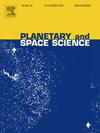Deep learning identification of asteroids interacting with g-s secular resonances
IF 1.7
4区 物理与天体物理
Q3 ASTRONOMY & ASTROPHYSICS
引用次数: 0
Abstract
Secular resonances occur when there is a commensurability between the fundamental frequencies of asteroids and planets. These interactions can affect orbital elements like eccentricity and inclination. In this work, our focus is to study the resonance, which affects highly inclined asteroids in the inner main belt around the Phocaea family. Traditionally, the identification of these asteroids was done manually, which demanded a significant amount of time and became unfeasible due to the large volume of data. Our goal is to develop deep learning models for the automatic identification of asteroids affected by this resonance. In this work, Convolutional Neural Network (CNN) models, such as VGG, Inception, and ResNet, as well as the Vision Transformer (ViT) architecture, are used. To evaluate the performance of the models, we used metrics such as accuracy, precision, recall, and F1-score, applied to both filtered and unfiltered elements. We applied deep learning methods and evaluated which one presented the best effectiveness in the classification of asteroids affected by the secular resonance. To improve the performance of the models, we employed regularization techniques, such as data augmentation and dropout. CNN models demonstrated excellent performance with both filtered and unfiltered elements, but the Vision architecture stood out, providing exceptional performance across all used metrics and low processing times.
与g-s长期共振相互作用的小行星的深度学习识别
当小行星和行星的基本频率之间存在通约性时,就会发生长期共振。这些相互作用会影响轨道元素,比如偏心率和倾角。在这项工作中,我们的重点是研究g−g6−s+s6共振,它影响着Phocaea家族周围内主带的高倾斜小行星。传统上,这些小行星的识别是手工完成的,这需要大量的时间,并且由于数据量大而变得不可行。我们的目标是开发深度学习模型,用于自动识别受这种共振影响的小行星。在这项工作中,使用了卷积神经网络(CNN)模型,如VGG, Inception和ResNet,以及视觉变压器(ViT)架构。为了评估模型的性能,我们使用了诸如准确性、精度、召回率和F1-score等指标,这些指标应用于过滤和未过滤的元素。我们应用深度学习方法,并评估哪一种方法在受长期共振影响的小行星分类中表现出最佳效果。为了提高模型的性能,我们采用了正则化技术,如数据增强和dropout。CNN模型在过滤和未过滤元素上都表现出出色的性能,但Vision架构脱颖而出,在所有使用的指标和较低的处理时间上都提供了出色的性能。
本文章由计算机程序翻译,如有差异,请以英文原文为准。
求助全文
约1分钟内获得全文
求助全文
来源期刊

Planetary and Space Science
地学天文-天文与天体物理
CiteScore
5.40
自引率
4.20%
发文量
126
审稿时长
15 weeks
期刊介绍:
Planetary and Space Science publishes original articles as well as short communications (letters). Ground-based and space-borne instrumentation and laboratory simulation of solar system processes are included. The following fields of planetary and solar system research are covered:
• Celestial mechanics, including dynamical evolution of the solar system, gravitational captures and resonances, relativistic effects, tracking and dynamics
• Cosmochemistry and origin, including all aspects of the formation and initial physical and chemical evolution of the solar system
• Terrestrial planets and satellites, including the physics of the interiors, geology and morphology of the surfaces, tectonics, mineralogy and dating
• Outer planets and satellites, including formation and evolution, remote sensing at all wavelengths and in situ measurements
• Planetary atmospheres, including formation and evolution, circulation and meteorology, boundary layers, remote sensing and laboratory simulation
• Planetary magnetospheres and ionospheres, including origin of magnetic fields, magnetospheric plasma and radiation belts, and their interaction with the sun, the solar wind and satellites
• Small bodies, dust and rings, including asteroids, comets and zodiacal light and their interaction with the solar radiation and the solar wind
• Exobiology, including origin of life, detection of planetary ecosystems and pre-biological phenomena in the solar system and laboratory simulations
• Extrasolar systems, including the detection and/or the detectability of exoplanets and planetary systems, their formation and evolution, the physical and chemical properties of the exoplanets
• History of planetary and space research
 求助内容:
求助内容: 应助结果提醒方式:
应助结果提醒方式:


